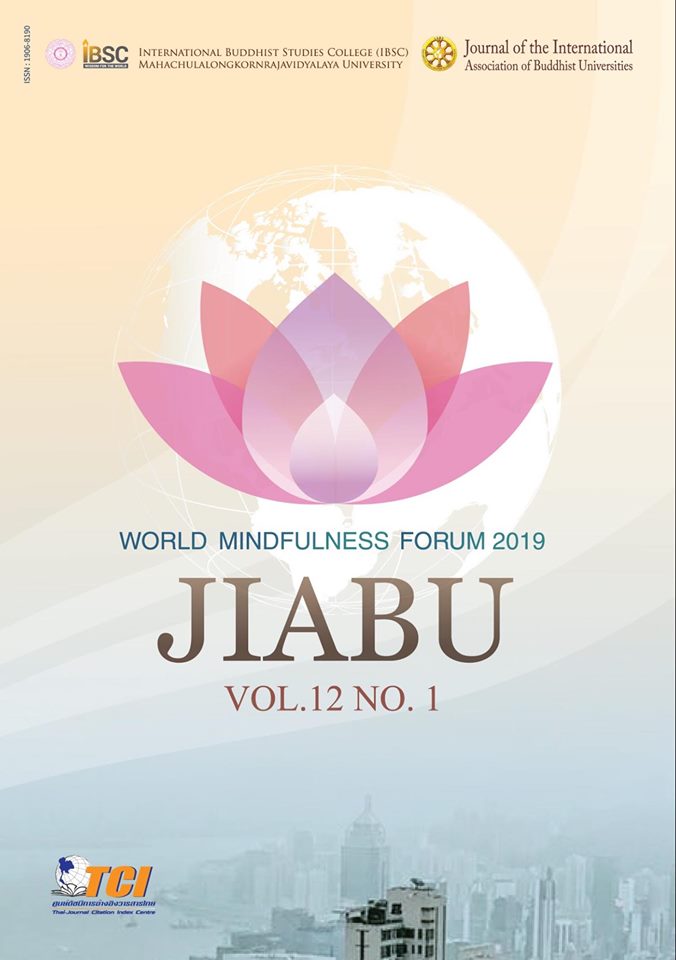The Paths to Attaining Enlightenment in Theravāda and Mahāyāna Buddhism and Their Application into Daily Life
Main Article Content
Abstract
The article aims to demonstrate the Paths to attaining Enlightenment in Theravāda and Mahāyāna schools leading to the same highest goal in Buddhism, the Theravāda school is the practice of thirty-seven Factors of Enlightenment to achieve Arahantship, nevertheless the Mahāyāna school emergence is the practice of the Bodhisattva Path through the complete Perfections (Pāramitās) to attaining Buddhahood. As a result, the harmonization of the Arahant Path and the Bodhisattva Path is the sacrifice of Arahant and Bodhisattva lives to bring compassion and loving kindness in serving others in the world as the way of the Buddhist Paths attaining enlightenment applies into daily life. After all, through a drawing of both Paths in Buddhism, it illustrates a comprehensive of the Paths to attaining enlightenment in Theravāda and Mahāyāna Buddhism and the application leading to happiness and peacefulness in daily life.
Article Details
Views and opinions expressed in the articles published by The Journal of the International Association of Buddhist Universities (JIABU), are of responsibility by such authors but not the editors and do not necessarily reflect those of the editors.
References
Bodhi, Bhikkhu. (2013). Arahants, Buddha and Bodhisattva, Nyanatusita himi, Bhikkhu. (ed.). The Bodhisattva Ideal: Essays on the Emergence of Mahāyāna. Kandy: Buddhist Publication Society.
Buddhaghosa, Bhadantācariya. Ñāṇamoli, Bhikkhu. (tr.). (2010). The Path of Purification (Visuddhimmagga). Kandy: Buddhist Publication Society.
Buswell Jr., Robert E. and Lopez Jr.,Donald S. (2014). The Princeton Dictionary of Buddhism. Oxford: Princeton University Press.
Dhammananda, K. Sri. (tr.). (1988). The Dhammapada. Kuala Lumpur: Sasana Abhiwurdhi Wardhana Society.
Conze, Edward. (tr. & ed.). (1990). The Large Sutra on Perfect Wisdom. Delhi: Motilal Banasidass Publishers.
Cowell, E. B. (tr.). (2008). The Jātaka, vol I-II-III-IV-V-VI. Delhi: Motilal Banarsidass Publishers.
Davids, T. W. Rhys. and Stede, William. (eds.). (2004). Pali-English Dictionary. Oxford: PTS.
Dayal, Har. (1932). The Bodhisattva Doctrine in Buddhist Sanskrit Literature. Delhi: Motilal Banarsidass.
H. Cook, Francis. (tr.). (1999). Three Texts on Consciousness Only. USA: Numata Center. Hare, E. M. (tr.). (1995). The Book of the Gradual Saying (Anguttaranikāya), vol III and IV.
Oxford: PTS.
Horner, I.B. (tr.). (1993). The Collection of the Middle Length Sayings (Majjhimanikāya). vol I, II, & III. Oxford: PTS.
Katz, Nathan. (1989). Buddhist Images of Human Perfection: the Arahant of the Sutta Piṭaka Compared with the Bodhisattva and the Mahāsiddha. Delhi: Motilal Banarsidass Publishers.
McRae, John R. (translated from the Chinese versions, Taisho text 475, vol 12), (2004). The Sutras of Queen Śrīmālā of the Lion’s Roar & the Vimalakīrti Sutra. USA: BDK America, Inc.
Nhat Hanh, Thich. (1998). The Heart of the Buddha’s Teaching, New York: Broadway.
Norman, K. R. (tr.). (2001). The Group of Discourses (Sutta Nipāta). Oxford: PTS.
Rhys Davids, T. W. and Stede, William. (eds.). (2004). Pali-English Dictionary. Oxford: PTS.
. and Carpenter, J.E. (eds.). (1995). Dīgha Nikāya. vol I, II. Oxford: PTS.
Shantideva. Geshe Kelsang Gyatso (trs.). (2007). Bodhisattvacharyavatara (Guide to the Bodhisattva’s Way of Life: a Buddhist Poem for Today). England: Tharapa Publications.
Suzuki, D.T. (1999). Studies in the Laṅkāvatāra Sūtra. New Delhi: Munshiram Manoharlal Publishers.
Tue Si, Most Venerable Thich. and Śraddhāpa, Dharmacārī. (tr.). (2004). full trans. Bhikṣunī Shih Heng-ching (translated from the Chinese of Dharmarakṣa. The Sutra on Upāsaka Percepts. California: Numata Center for Buddhist Translation and Research.
Thiṭṭila, Paṭhamakyaw Ashin. (tr.). (1995). The Book of Analysis (Vibhaṅga). Oxford: PTS. Warren, H.C. and Kosambi, D. (ed.). (1950) Visuddhimagga of Buddhaghosācariya. London:
Oxford University Press.
Walshe, Maurice. (tr.), (2012). The Long Discourses of the Buddha: A Translation of the Dīgha Nikāya. Boston: Wisdom Publication.
Woodward, F. L. (tr.). (1994). The Book of the Kindred Sayings (Saṁyutta-Nikāya). vol III, IV, & V. Oxford: PTS.
. (tr.). (1995). The Book of the Gradual Saying (Anguttaranikāya). vol. I, II, & V. Oxford: PTS.
2. Online Sources
Amaro, Ajahn. “Between Arahant and Bodhisattva.” (2016). Lion’s Roar: Buddhist Wisdom for Our Time. https://www.lionsroar.com/between-arhat-and-bodhisattva/
Tue Si, Most Venerable Thich. and Śraddhāpa, Dharmacārī (tr.), full trans. Bhikṣunī Shih Heng-ching (translated from the Chinese of Dharmarakṣa). (2004). The Sutra on Upāsaka Percepts. California: Numata Center for Buddhist Translation and Research. http://www.sutrasmantras.info/sutra33a.htm
Harper, Joanna. How to Practice Loving-Kindness. (2017) https://www.lionsroar.com /how-to- practicelovingkindness/?utm_content=bufferb2ce0&utmmedium=soci al&utm_source =facebook.com&utm_campaign=buffer
R. McRae, John. (translated from the Chinese versions, Taisho text 475, vol 12). (2004) The Sutras of Queen Śrīmālā of the Lion’s Roar & the Vimalakīrti Sutra. USA: BDK America, Inc. http://www.bdkamerica.org/system/files/pdf/dBET_Srima la_Vimalakirti_2004_0.pdf?file=1&type=node&id=480


